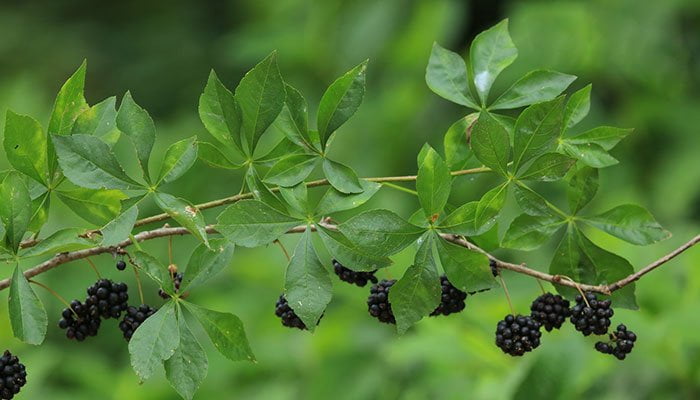What Is Wu Jia Pi
Wu Jia Pi commonly known as Cortex Acanthopanacis is the root bark of Eleutherococcus nodiflorus, which is a deciduous undershrub belonging to the family Araliaceae. It is a relatively practical and common Chinese herbal medicine, which first appeared in <Shennong Ben Cao Jing> in the late Western Han Dynasty (around 100 BCE).
There are about 29 kinds of Eleutherococcus, which are mainly distributed in East Asia. Some of these species are of medicinal value, such as Eleutherococcus nodiflorus, E. sessiliflorus, E. giraldii, E. henryi, E. leucorrhizus, E. cissifolius, and E. senticosus.
Eleutherococcus nodiflorus is also known as Acanthopanax gracilistylus. This plant is unique to China. They are distributed in central, eastern, southern, and southwestern China. They often grow on forest edges, roadsides, or thickets. Currently, they have been cultivated artificially.

In summer and autumn, people gather the roots of Eleutherococcus nodiflorus, wash them with water, peel the root barks, dry them in the sun, cut them into thick slices, and make them into Chinese herbal medicines.
Wu Jia Pi contains syringin, eleutheroside B1, acanthoic acid, sesamin, protocatechuic acid, acanthoside A-D, acanthoside K2, acanthoside K3, acankoreagenin, acankoreanogenin A, stigmasterol, β-sitosterol, polysaccharides, volatile oils, fatty acids, proteins, and vitamins.
Generally, light yellowish-brown and thick Wu Jia Pi with a slightly fragrant is preferred.
According to <Compendium of Materia Medica>, the medicinal nature of Wu Jia Pi is relatively warm, with a pungent and bitter taste. It has a certain therapeutic effect on the pathological changes of the liver and kidney meridians.
In traditional Chinese medicine, it is often used to expel wind and dampness, reinforce liver benefit kidney, strengthen tendons and bones, promote urination to alleviate edema, and treat rheumatic arthralgia, waist and knee pain, muscular spasms, flaccid tendons and bones, dysplasia in children, retardation in infants, fatigue, edema, bad breath, beriberi, palpitations, insomnia, neurasthenia, productive spondylitis, proliferative cervical syndrome, lumbar muscle degeneration, facial distortion, and hemiplegia.
There are about 50 kinds of traditional Chinese medicine prescriptions containing it, such as Zhi Zhi Pian, Kuo Kung Chiew, and Zhuang Jin Xu Gu Wan.
Benefits
- Anti-inflammation, inhibiting carrageenan-induced paw swelling in rats.
- Increasing pain threshold, prolonging the time of licking hindfoot in mice induced by hot plate experiment.
- Anti-oxidation, scavenging DPPH free radicals and ABTS free radicals.
- Inhibiting the activity of α-glucosidase, α-amylase, and PTP1B, increasing the insulin release, and protecting the pancreas β-cell [1].
- Reducing galactosamine and lipopolysaccharide-induced acute liver injury and protecting the liver [2].
- Inhibiting the proliferation of human peripheral blood lymphocytes caused by concanavalin A and Staphylococcus aureus Cowan I in vitro [3].
- Expelling wind and dampness, treating rheumatic arthralgia, waist and knee pain, and muscular spasms.
- Reinforcing liver benefiting kidney, treating insufficiency of liver and kidney, flaccid tendons and bones.
- Strengthening tendons and bones, treating dysplasia and retardation in children.
- Promoting urination and treating edema caused by the accumulation of cold and dampness.
- It cooperates with pentobarbital sodium to prolong the sleep time of experimental mice.
- Its chloroform extract has a strong inhibitory effect on acetylcholinesterase and butyrylcholinesterase [4].
- In vitro cell viability test showed that it only inhibited the proliferation of tumor cells, and couldn’t lead to the death of cells [5].
- Studies have found that its aqueous extract can prevent ovariectomy-induced rats from gain of the body weight. It can inhibit bone resorption, reduce serum level of IL-1β and increase the level of calcitonin in OVX rats [6].
Combinations
- It can be used in combination with Dang Gui (Radix Angelicae Sinensis), Niu Xi (Radix Achyranthis Bidentatae), Di Yu (Radix Sanguisorbae), etc. to treat rheumatic arthralgia, waist and knee pain, muscular spasms.
- It can be used in combination with Niu Xi (Radix Achyranthis Bidentatae), Du Zhong (Eucommia Bark), etc. to treat insufficiency of liver and kidney, flaccid tendons and bones.
- It can be used in combination with Gui Jia (Carapax et Plastrum Testudinis), Niu Xi (Radix Achyranthis Bidentatae), Mu Gua (Fructus Chaenomelis), etc. to treat dysplasia and retardation in children.
- It can be used in combination with Fu Ling (Poria), Da Fu Pi (Pericarpium Arecae), Sheng Jiang (Rhizoma Zingiberis Recens), etc. to treat dysuria and edema.
- It can be used in combination with Mu Gua (Fructus Chaenomelis), Can Sha (Faeces Bombycis), Wu Zhu Yu (Fructus Evodiae), etc. to treat edema caused by the accumulation of cold and dampness.
Side Effects
- At present, there is no literature report that Wu Jia Pi has toxic effects.
- Long-term or excessive use of it may cause adverse reactions such as dizziness, headache, numbness of limbs, facial paralysis, chills in the lower extremities, throat discomfort, slurred speech, and dry stools.
Precautions and Warnings
- The dosage of Wu Jia Pi should be controlled at 5-10g.
- It can be made into decoctions, pills, lotions, medicinal liquors, or ground for external use.
- People who are allergic to Wu Jia Pi should not take it.
- People with hyperactivity of fire due to yin deficiency should not take it.
- Pregnant and breastfeeding women should take it under the guidance of a doctor.
- Children and the elderly should take it under the guidance of a doctor.
